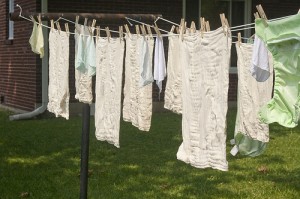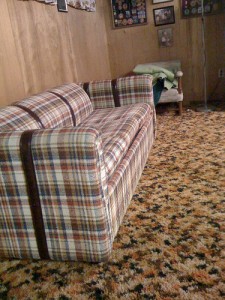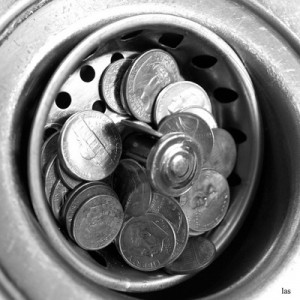Since I wrote an update on how line drying is going and what I’ve learned from that last week, I thought I’d share how things are going with our little vegetable garden.
You might recall, I’ve had trouble with container gardening in the past. I worried that I was doomed to a black thumb forever. Thankfully, that doesn’t seem to be the case. My little vegetable garden is doing pretty well considering how late in the season it was planted and how little I knew what I was doing when I started.
Here’s how it looked right after I planted it:
And here it is yesterday:
Unbelievable what sunshine, water, and time can do for a garden!
I sort of rushed planting this garden, because it was late in the season, and I wanted to get some experience under my belt before I try my hand at some more ambitious gardening next year. I’d like to plant directly into the ground next season, but that’s going to take some considerable prep time that I just didn’t have this year. Instead, I put this tiny raised bed into the existing flower bed in front of the house. I planted red pepper, tomato, cucumber, sage, peppermint, parsley, oregano, rosemary, and basil.
The cucumber plant is my biggest success. I’ve already picked two cucumbers, and I see about 10 or 15 more tiny ones growing now. The basil and rosemary are thriving, and we’ve gotten the most use out of the basil for pizzas, pesto, and other cooking. I’m not quite sure what to do with the other herbs, but I want to harvest them late in the season and try my hand and drying them out for later use. I was worried about the tomato for a while, because I wasn’t seeing any signs of fruit, but now I’ve got several blossoms. I’m hoping to see at least some tomatoes, but I probably could have grown more if I hadn’t waited until the middle of June to plant.
Because I was so rushed, I made a ton of mistakes. But I learned! And that’s what’s important, right?
Lesson #1: Cages should go on tomatoes, cucumbers, and any other plant you want to grow vertically immediately after planting. This isn’t something you can do later. Doh. Consequently, when the cucumber and tomato plants started taking over my garden, I tried to rig a cage to hold them up. It’s sort of doing the job, but not as effectively as it should. I feel pretty stupid about this one, because it seems so obvious now.
Lesson #2: Plan your garden carefully and avoid giant plants in tiny beds. Seriously, look at that tiny little cucumber plant in the first photo. I had NO IDEA the thing would grow to be so giant and try to take over the entire bed. I had an idea about the size of tomato plants, but I probably shouldn’t have planted the red pepper plant right next to it. Sadly, my red pepper plant is not going to make it because it’s so overshadowed by the tomato. I was able to rig the cucumber plant in a cage to prevent it from taking over everything, but the parsley isn’t doing well because it’s under the cucumber.
Lesson #3: Plant what you eat. I sort of grabbed the plants that looked best to me, and there wasn’t a lot left in the middle of June. I knew we’d have a ton of uses for basil, but I’m sort of at a loss for what to do with the rest of the herbs. And I have no clue what I’m going to do with 20 cucumbers that will likely ripen within a week or two. I see lots of pickles in our future. When I plant my big garden, I’m going to be more careful about selecting what to plant to ensure that we get lots of use out of the food we grow.
Lesson #4: Gardening doesn’t always save money. I had hoped my garden would reduce our grocery bill. It’s taking forever to grow anything, though, and most of the herbs are things we don’t use regularly anyway. Between plants, the prefab raised beds, and soil (who knew soil was so expensive?!), I spent about $100 on my garden. I doubt I’ll yield enough to cover my overhead this season.
Next year I’ll lower my costs my planting directly into the ground (or building raised beds myself from lumber). We plan to start a compost bin soon, which will provide us with fertilizer, and tilling the soil and planting in the ground will mostly eliminate the high cost of soil. I will probably still buy seedlings next year, because I’m not confident enough in my ability to grow from seeds just yet. But in the future, I’d like to grow from seeds to cut down on plant costs. I also plan to learn about canning so we can make the most of our harvest during the winter months.
In other news, I’d like to welcome Merchant Warehouse as a new partner. They offer credit card processing services, and I’m happy to have them onboard. Click through to check them out if you’d like to process credit cards on your website!









